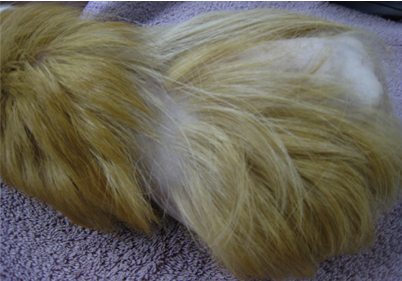Ovarian Cysts in Guinea Pigs
Ovarian cysts are fluid filled structures that develop on or near the ovary. There are many types of ovarian cysts and their prevalence in guinea pigs ranges from 58-100%. The two main types are 1) serous cysts, also known as nonfunctional or rete ovarii cysts, and 2) hormone producing follicular cysts. Rete cysts are non-hormone producing and typically do not cause clinical signs unless they are large and pushing on other organs. Follicular cysts develop from follicles on the ovary that fail to ovulate. When these types of cysts develop, the classic sign is non-itchy flank hair loss. Other signs include decreased appetite, gradual increase in abdominal size, behavioral changes and possibly decreased defecation. Physical exam may reveal a round mass/masses on abdominal palpation as well as changes to the nipples like hyperkeratosis and hyperpigmentation. The other less common types are 3) neoplastic cysts which are ovarian cancer with cystic characteristics and 4) parovarian cysts which are the rarest and derive from the parovarium, a remnant structure of the ovary from development. How and why development of cystic ovaries happens is not fully understood but there are many different theories.

Hair loss or endocrine alopecia typical of guinea pigs with ovarian cysts.
Suspicion of ovarian cysts in guinea pigs is made by presenting history and physical exam findings, and diagnosed with radiography and abdominal ultrasound. Ultrasound usually reveals a thin-walled fluid filled suggestive of ovarian cysts.
Ovariohysterectomy, or spaying, is the recommended treatment, especially in rete cysts because the surgery is curative and rete cysts do not respond to medical/hormone treatment. However, ovariohysterectomies can be challenging due to the anatomy of the guinea pig reproductive tract where the ovaries are located high up close to the kidneys. If surgery is not an option, supportive care can also be performed by drainage of the fluid; however, the cysts are likely to return even within a matter of days. Follicular cysts can be hormone responsive and historical treatment has been with human chorionic gonadotropin (hCG) injections but this is a controlled substance and hard to find for veterinary use. Hormone implants (Deslorelin) and injections (Lupron) have not been shown to work in guinea pigs.

Reproductive tract of a guinea pig being spayed showing the large, fluid filled cysts near the ovaries.
Prognosis depends on the type of cysts, treatment chosen, and overall health of the animal. Although surgery is curative, it does come with risk. Cyst drainage can be a form of relief but it is not a long-term resolution. Hormone therapy has variable efficacy, especially since it may work in only one type of cyst and there is no definitive way to know what type of cyst a guinea pig has without surgically removing it and sending it out to a laboratory for histopathology.



